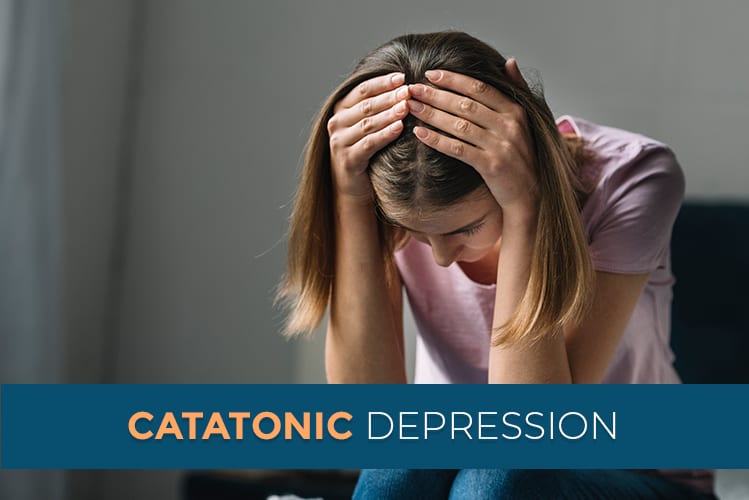Depression is a major disorder that affects a person negatively and causes impairment in daily life. Many people have undergone depression at some point in their lives. Depression can be identified and treated. However, there are severe stages of depression that change a person’s life completely. Catatonic depression is one of the severe kinds of depression that can put people into a stupor. This depression is characterized by the affected person being speechless and motionless for a long period of time. Here the person does not respond to his or her surrounding environment. If you know someone suffering from catatonic depression or want to know about catatonic depression then this article might be of interest.
What is Catatonic Depression?
Catatonia comes from two Greek words “Kata” meaning down and “tonas” meaning tension. This depression occurs when a person enters the catatonic state (lack of speech and immobility). Catatonic depression affects the individual’s motor skills. People with catatonia remain still and do not respond to any events/things around them. There are three types of catatonia, namely akinetic catatonia, excited catatonia, and malignant catatonia. Akinetic catatonia is the most commonly observed in people with catatonic depression, whereas malignant catatonia can be dangerous, causing severe health effects.
Causes of Catatonic Depression
Doctors believe catatonic depression can be caused by other underlying mental health disorders, such as schizophrenia, mood disorders, and post-traumatic stress disorder. However, the exact cause of catatonic depression is not known. A collapse or irregular production of neurotransmitters dopamine and serotonin can trigger depression and cause catatonia.
It has also been noted that people with past depression who experience trauma are prone to catatonic depression. For example, a traumatic event or losing a loved one can cause mental trauma. As an outcome, the individual encounters extreme emotional stress, which causes him or her to enter a catatonic state. Although the exact cause of catatonic depression is unknown, certain theories hold that catatonic depression can be caused by a deficiency in gamma-aminobutyric acid (GABA), dysregulation in glutamate, and abnormalities of metabolism in the thalamus and frontal lobes.
Signs and Symptoms of Catatonic Depression
Catatonia includes different signs and symptoms. The following are possible signs noted in patients with catatonia.
- Automatic obedience – The patient automatically obeys all instructions given by the doctor.
- Ambitendency – The patient alternates between cooperating with the doctor’s instructions and resisting them.
- Aversion – The patient turns away when he or she is being spoken to.
- Echopraxia – The patient imitates the activities of the person speaking with him or her.
- Excitement – The patient engages in excessive and purposeless action that is not driven by outside stimuli.
- Negativism – The person is always having negative thoughts and feels sad every day.
- Stupor – This is one of the common signs of catatonia. It is characterized by a lack of mobility and speech.
- Posturing – The person remains in the same posture for a long period of time.
- Mutism – The person is verbally unresponsive and refuses to speak.
- Staring – The individual’s eye is fixed on a particular space and open for long periods of time.
Recovery and Treatment
Benzodiazepines and Electroconvulsive Therapy (ECT) are the two major treatments for catatonia.
Benzodiazepines
Benzodiazepines are a common first-line treatment for catatonia. These are psychoactive drugs which are effective in relieving the catatonic symptoms, including muscle spasms, anxiety, and insomnia. As benzodiazepines are sedatives and highly addictive, they are used as a short-term treatment. Lorazepam is the commonly prescribed benzodiazepine for patients with catatonia.
Electroconvulsive Therapy (ECT)
Electroconvulsive therapy is found to be very effective, even after the first-line treatment of benzodiazepines fails. It is an electroshock therapy by which mild electric currents are passed to the brain to retrieve a patient from the catatonic state. Some consider this treatment to be unsafe, as it may cause seizures and side effects.
N-methyl-D-aspartate
Few researchers suggest using N-methyl-D-aspartate antagonists to treat catatonic depression. This treatment reduces the glutamate excitotoxicity and resolves the gamma-aminobutyric acid (GABA) hypofunction observed in catatonia. However, this treatment is sometimes given for patients diagnosed with delirium and catatonia. More studies are needed to determine its effectiveness in treating catatonic depression.
Repetitive Transcranial Magnetic Stimulation (rTMS)
This treatment is used to stimulate the patient’s brain and it is a common treatment used to treat depression and anxiety. Brain stimulation involving magnetic fields to cause electric current is done in catatonic patients, targeting a specific area of the brain.
Conclusion
Catatonia is a syndrome (a group of symptoms which consistently occur together), and long-term treatment is necessary to cope with the symptoms. Ruling out other medical conditions is imperative for the treatment and recovery of catatonic depression. People with catatonia who do not receive proper treatment are at risk of developing other conditions such as malnutrition, pneumonia, decubitus ulcers, shortening of muscles and dehydration. Acute psychiatric care is essential for a person suffering from catatonia. However, scientists continue to do research to study this syndrome’s epidemiology.
If you or someone you know experiences mental health issues, it is important to seek help from a qualified professional. Our Resource Specialist can help you find expert mental health resources to recover in your community. Contact us now for more information on this free service to our users.
Author Bio: Gifty Narkani is a Content Writer at Pulse Plus, the most trusted online medicine sellers in India. She specializes in guest blogging, loves to publish articles, and is a winner in social media campaigns. Gifty is well-versed in niches such as health benefits and medical news.
The opinions and views expressed in this guest blog do not necessarily reflect those of www.rtor.org or its sponsor, Laurel House, Inc. The author and www.rtor.org have no affiliations with any products or services mentioned in this article or linked to herein.
Recommended for You
- The Truth about Relapse in Addiction Recovery - April 14, 2025
- The Power of Peer Support in Mental Health Recovery - April 10, 2025
- Artificial Intelligence in Anxiety Management: How AI Helps Users Cope with Anxiety Symptoms - April 3, 2025






Thanks, I have recently been hunting for info about this subject matter for ages and yours is the best I have located so far.
I had a catatonic stress reaction 2 years ago and also have MDD. Since then, I feel slow and my muscles tighten whenever I am stressed. It is difficult to talk and move but isn’t full catatonia. I feel like I’ve had too many traumatic experiences and part of catatonia is my mind and body protecting itself. Or shutting down because of overload. Just a qualitative perspective lol Thanks for the article.
Hi Jess,
Thank you for reading and commenting on our guest blog. If you are not already and are interested in therapy to address some of your traumatic experiences. Please feel free to email us at help@rtor.org for treatment options.
-Danielle